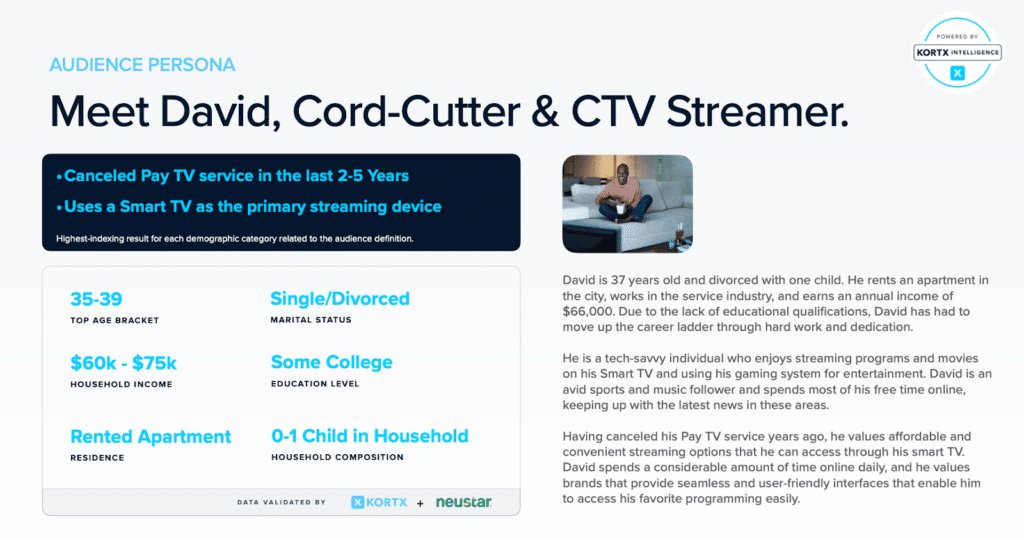Media consumption is fragmented. Viewers enjoy content on their own terms across traditional cable, streaming platforms, and devices.
How can advertisers connect with customers who consume content on so many devices and platforms?
Start with addressable television audiences. Addressable TV advertising customizes ads for different households watching the same linear TV program. Meanwhile, addressable CTV goes a step further by targeting all streaming devices in a household with personalized ads.
Read more about addressable TV, how it works, and how it compares to addressable CTV.
What is Addressable TV Advertising & How Is It Different from Other Solutions?
Addressable TV delivers varying ads to different target groups of viewers watching the same linear TV program. Targeting is based on factors like age, interests, or habits.
Although addressable TV has existed since 2012, the recent boom in streaming services and widespread popularity of Connected TV (CTV) have transformed it into another form: addressable CTV.
Addressable TV vs. Linear TV
Addressable TV is a form of linear TV with significantly improved targeting capabilities.
In traditional linear TV advertising, ads are broadcast to a broad audience without the ability to target specific demographics or individuals.
Addressable allows advertisers to deliver ads to specific households or audience segments based on various data points such as demographics, interests, purchase behavior, and viewing habits.
🔑 Key Difference
- Linear TV: Broadcasts scheduled programming to a broad audience, regardless of individual preferences.
- Addressable TV: Enhances linear TV by using targeted advertisements for different households based on data.
Addressable TV vs. CTV (Connected TV)/OTT (Over-the-Top)
Addressable TV and CTV (Connected TV)/OTT use different platforms and technologies to help companies show their ads to the right people.
Addressable TV delivers TV ads only through cable connections and targets specific households based on basic data like set-top box information and household demographics.
Addressable CTV/OTT advertising extends beyond traditional TV devices to include the full spectrum of cross-device reach, encompassing mobile phones and tablets.
Utilizing a diverse dataset—including location, demographics, and online behavior—CTV/OTT targets ads to individuals or households across multiple devices. With OTT, you can target specific shows, like an HGTV episode, to help reach more relevant viewers.
🔑 Key Difference
- Addressable TV: Limited to linear household advertising only.
- CTV/OTT: For all internet-connected streaming TV devices like smart TVs, gaming consoles, and mobile devices.
How Does Addressable TV Advertising Work?
Addressable TV advertising integrates data analytics, sophisticated software, and digital technology into linear TV broadcasting systems.
Here’s a step-by-step breakdown of how it typically works:
- Data Collection and Integration: Service providers gather viewer data via set-top boxes, smart TVs, and apps, incorporating external data to enrich audience profiles.
- Audience Segmentation: Viewers are categorized into segments using data analytics based on characteristics like demographics and interests.
- Ad Matching: Advertisers target specific viewer segments based on campaign goals, matching ads to the most relevant audiences.
- Ad Insertion: Targeted ads are dynamically inserted into commercial breaks for specific viewer segments, leveraging set-top boxes and smart TV technology.
- Measurement and Optimization: Ad performance is measured using metrics like reach and conversion, enabling advertisers to optimize future campaigns based on viewer engagement data.
Addressable increases the ads’ relevance and helps reduce advertising costs by targeting only those most likely to be interested in the advertised product or service.
How do I buy addressable TV advertising?
Advertisers can purchase addressable TV advertising directly from TV networks, through media buying agencies, programmatic platforms, or by engaging with addressable TV providers.
The Benefits of Addressable TV
Addressable TV advertising campaigns improve the viewer experience, marking a significant shift from traditional advertising methods like linear TV.
1. Precise Targeting
Addressable TV advertising’s precision targeting capabilities enable advertisers to deliver specific messages directly to the intended audience segment.
Ads are seen and resonate with viewers, leading to higher engagement rates, improved brand recall, and ultimately, a stronger impact on consumer behavior.
Addressable TV Examples:
☑️ During election seasons, political campaigns often use Addressable TV to target specific voter demographics with tailored messages, maximizing their impact.
🏢 Small businesses can focus on reaching local customers within their vicinity, reducing ad wasted ad spend and improving ROI.
2. Significant Market Growth
Addressable ad spending (including for addressable CTV) continues to grow in the US, potentially reaching $29.29 billion as strategies shift towards more personalized and data-driven approaches.
3. Increased Advertiser Acceptance
80% of advertisers expressed satisfaction with the outcomes of their addressable initiatives. Furthermore, 83% of advertisers say that buying addressable ads has increased their ability to meet campaign objectives.
Such a strong endorsement is a testament to addressable TV’s capability to meet and exceed advertiser expectations.
4. Enhanced Campaign Outcomes
Addressable advertising enhances campaign performance across various sales funnel stages.
The ability to measure and adjust campaigns in real-time based on viewer responses means campaigns are constantly optimized for performance.
How does addressable TV enhance linear campaign effectiveness?
“TV Addressable advertising continues to build momentum as we evolve towards an impression-based, converged TV landscape. Addressability has helped make television advertising effective at every sales funnel stage.”

Addressable CTV Advertising: Going Beyond Linear Targeting
Along with the great benefits of addressable TV advertising, CTV (Connected TV) offers additional benefits.
1. Rapid Growth
Streaming services continue to surge, leading to a significant increase in CTV viewership.
💡 In 2019, 24.6 million households had cut the cord, projected to hit 46.6 million in 2024.
2. Advanced Targeting
Addressable CTV advertising, however, enables micro-targeting, allowing advertisers to reach highly specific audience segments for increased engagement.
This broader perspective helps improve targeting effectiveness across various platforms and channels.

An example of an audience persona we built to increase targeting effectiveness.
CTV Targeting with KORTX: People First Targeting
KORTX Intelligence analyzes thousands of user attributes from diverse sources, including your own First-Party data, to create detailed audience profiles & boost targeting capabilities.
3. Cross-Device Reach
With addressable CTV ads, advertisers can reach consumers across multiple devices within a household, including smart TVs, streaming devices, mobile phones, and tablets.
Cross-device targeting allows marketers to reach users wherever they are, increasing the likelihood of engagement and conversions.
💡 Device Graphs, like KORTX’s, anonymously link individual devices to a single user. This provides a comprehensive view of the devices in a household.

4. Measurement and Attribution
Addressable CTV allows advertisers to track the performance of their campaigns in real-time. Metrics such as impressions, viewability, completion rates, and conversion tracking enable advertisers to optimize their campaigns for maximum ROI and overall success.
💡 Consolidating data into one dashboard, like KORTX’s Kampus, streamlines campaign analysis and decision-making processes in Addressable CTV advertising.
5. Interactive CTV Ads
CTV platforms support interactive CTV ad formats, allowing advertisers to deliver viewers engaging and immersive ad experiences.
Interactive overlays, shoppable ads, and personalized content enhance viewer engagement and drive action, leading to higher ad recall and conversion rates.
💡 In the last year, interactive CTV campaigns drove a 5.42% engagement rate, compared to a rate of 0.97% for mobile and PC.

An example of an interactive CTV ad. eCommerce brands could use shoppable Picture-in-Picture (PiP) ads to drive users to their website through a simple QR code phone scan.
How does addressable TV differ from addressable CTV?
“The key difference lies in the technology and data capabilities: Addressable TV is bound by the constraints of linear broadcast infrastructure, while addressable CTV thrives on the flexibility and advanced targeting possibilities offered by digital streaming platforms.”

Making the Choice: Addressable TV vs. CTV
The choice between Addressable TV and CTV depends on your campaign objectives and target audience.
Addressable TV excels in precision targeting within traditional broadcasting, while CTV offers the versatility of internet-driven, interactive advertising. Consider your goals and the nature of your audience to determine which platform aligns best with your strategy.
About the Author
Drew Pytel is a Senior Account Strategist at KORTX. He enjoys golf, bourbon, and being active with his wife and 3 kids.

